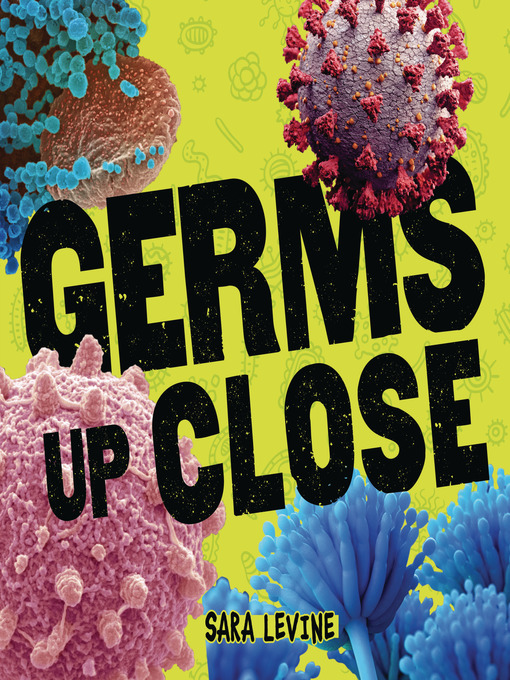- No wait, no problems
- Always Available Children's Titles
- Beginning Readers
- French Titles for Kids
- Indigenous Children's Books
- Rainbow Reads for Kids
- Popular titles
- See all ebooks collections
-
Creators
-
Publisher
-
Release date
April 6, 2021 -
Formats
-
OverDrive Read
- ISBN: 9781728427393
-
PDF ebook
- ISBN: 9781728424095
- File size: 5114 KB
-
-
Languages
- English
-
Levels
- ATOS Level: 5.5
- Lexile® Measure: 850
- Interest Level: K-3(LG)
- Text Difficulty: 4-5
-
Reviews
-
Booklist
February 15, 2021
Grades 2-4 Meet the strangers within us: the types of bacteria, protozoa, fungi, and viruses that sometimes cause illnesses, though other types are beneficial to people. After a paragraph introducing each category of germs, the presentation spotlights one after another with a pithy summary of its characteristics, as well as an illustration. Viruses are described as "just tiny bundles of instructions, called DNA or RNA, wrapped in a coat of protein." The adjacent, greatly enlarged image features the virus that causes rabies. Throughout the book, illustrations include a few photos of people, some labeled diagrams, and many highly magnified, surprisingly colorful images of germs, including COVID-19. The book's final section discusses the immune system, explains vaccines, and encourages preventive practices such as handwashing and coughing into elbows rather than hands. An unusual addition to the back matter is a list of 11 occupations involving germs, from epidemiologist to microbiologist to veterinarian. The latter is Levine's profession when she's not writing engaging children's science books, such as Tooth by Tooth (2016), Flower Talk (2019), and this timely volume.COPYRIGHT(2021) Booklist, ALL RIGHTS RESERVED.
-
School Library Journal
May 1, 2021
Gr 3-5-Upper elementary readers will be fascinated by the highly developed, brightly tinted micrographs and illustrations dominating Levine's informational book about germs and their effects on the human body. Perfect as a launch point resource to begin a science unit, Levine's succinct overview of germs provides basic particulars about bacteria, protozoa, fungi, and viruses, with visually dynamic examples of each. Simple, unembellished explanations introduce the four types of germs, while featured examples include pronunciation guides, habitat details, and "more to know" facts about how they may affect the human body. Coordinating frames and background color palettes segment the topics and main text around the boldly colored close-up shots. While formatted with well-placed labels, some visuals are marked with scientific names that go unexplained in the text, leaving readers to look up the subjects from outside sources. Levine includes a glossary and a brief resources list as back matter. In the section centered on viruses, which includes COVID-19 as an example, the author references scientific innovations in treatments, such as vaccine development and basic hygiene practices. In this manner, Levine brings readers "face-to-face" with microscopic germs to learn how they share our world and how we protect ourselves from those that are harmful. VERDICT Full of close-up visuals, this informational picture book provides basic, introductory support for explorations in upper-elementary science units about germs, including the COVID-19 virus, and brightly promotes the necessary correlation between scientific knowledge and health safety.-Rachel Mulligan, Westampton, NJ
Copyright 2021 School Library Journal, LLC Used with permission.
-
The Horn Book
January 1, 2021
This informative and accessible book begins by categorizing the four types of germs that make us sick: bacteria, protozoa, fungi, and viruses. Levine introduces each group with general information followed by brief profiles of two or three specific organisms (e.g., E. coli, giardia, trichophyton, coronavirus). She then covers how germs infect us, the immune system's job, and how vaccines work. The well-designed pages feature color-enhanced micrographs that provide a look at this usually unseen world. Appended are a glossary, suggested reading and websites, and a list of "Germy Jobs."(Copyright 2021 by The Horn Book, Incorporated, Boston. All rights reserved.)
-
Kirkus
February 15, 2021
A photo gallery of dangerous microbes, with basic guidelines for keeping them at bay. Though the quality of the microphotography falls off when Levine gets to explaining the immune-system roles that various types of white blood cells play, overall the pictures are the stars of the show. Most are big, bright of hue, and so clear that even the smallest physical details of bugs from E. coli to coronavirus stand out in sharp, precise definition. "Who would have imagined," writes Levine, "that they would be so interesting and beautiful to look at?" The author's strenuous efforts to keep her commentary simple may leave readers confused about whether all germs are by definition "bad" or are often or in certain conditions harmless or even beneficial (and it doesn't help that germ doesn't rate an entry in the closing glossary). Still, her concise notes about where each type or species of common bacterium, protozoan, fungus, and virus she names is typically found, the maladies they cause, and how vaccines, hand-washing, wearing masks, and other preventive measures can lend our sophisticated immune systems a hand are as clear as they are timely. Other introductions to the microworld, such as Steve Mould's The Bacteria Book (2018) and Amy Gallagher's Microbes (2017), offer broader informational pictures, but their cartoon illustrations may, for some, make that world seem a little less real. High-interest topic and eye-catching visuals--but a few rough spots keep it off the top shelf. (bibliography, list of medical occupations) (Informational picture book. 7-9)COPYRIGHT(2021) Kirkus Reviews, ALL RIGHTS RESERVED.
-
Formats
- OverDrive Read
- PDF ebook
subjects
Languages
- English
Levels
- ATOS Level:5.5
- Lexile® Measure:850
- Interest Level:K-3(LG)
- Text Difficulty:4-5
Loading
Why is availability limited?
×Availability can change throughout the month based on the library's budget. You can still place a hold on the title, and your hold will be automatically filled as soon as the title is available again.
The Kindle Book format for this title is not supported on:
×Read-along ebook
×The OverDrive Read format of this ebook has professional narration that plays while you read in your browser. Learn more here.




